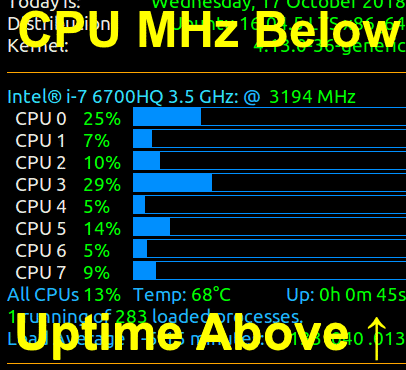默认的Ubuntu内核配置是在引导过程中使用性能CPU频率缩放调节器。内核配置文件(/boot/config-4.15.0-36-generic在此示例中)的相关部分是:
#
# CPU Frequency scaling
#
CONFIG_CPU_FREQ=y
CONFIG_CPU_FREQ_GOV_ATTR_SET=y
CONFIG_CPU_FREQ_GOV_COMMON=y
CONFIG_CPU_FREQ_STAT=y
CONFIG_CPU_FREQ_DEFAULT_GOV_PERFORMANCE=y
# CONFIG_CPU_FREQ_DEFAULT_GOV_POWERSAVE is not set
# CONFIG_CPU_FREQ_DEFAULT_GOV_USERSPACE is not set
# CONFIG_CPU_FREQ_DEFAULT_GOV_ONDEMAND is not set
# CONFIG_CPU_FREQ_DEFAULT_GOV_CONSERVATIVE is not set
# CONFIG_CPU_FREQ_DEFAULT_GOV_SCHEDUTIL is not set
CONFIG_CPU_FREQ_GOV_PERFORMANCE=y
CONFIG_CPU_FREQ_GOV_POWERSAVE=y
CONFIG_CPU_FREQ_GOV_USERSPACE=y
CONFIG_CPU_FREQ_GOV_ONDEMAND=y
CONFIG_CPU_FREQ_GOV_CONSERVATIVE=y
CONFIG_CPU_FREQ_GOV_SCHEDUTIL=y
#
# CPU frequency scaling drivers
#
CONFIG_X86_INTEL_PSTATE=y
CONFIG_X86_PCC_CPUFREQ=y
CONFIG_X86_ACPI_CPUFREQ=y
CONFIG_X86_ACPI_CPUFREQ_CPB=y
CONFIG_X86_POWERNOW_K8=y
CONFIG_X86_AMD_FREQ_SENSITIVITY=m
CONFIG_X86_SPEEDSTEP_CENTRINO=y
CONFIG_X86_P4_CLOCKMOD=m
但默认情况下,在启动过程中ondemand也会执行该服务。它睡觉包1分钟,然后或者改变缩放调速器interactive,ondemand或powersave,视情况而定。反过来,可用性取决于您使用的CPU频率缩放驱动程序。代码是(在多个位置搜索ondemand):
#! /bin/sh
### BEGIN INIT INFO
# Provides: ondemand
# Required-Start: $remote_fs $all
# Required-Stop:
# Default-Start: 2 3 4 5
# Default-Stop:
# Short-Description: Set the CPU Frequency Scaling governor to "ondemand"
### END INIT INFO
# Don't run if we're going to start an Android LXC container:
[ ! -f /etc/init/lxc-android-config.conf ] || exit 0
PATH=/sbin:/usr/sbin:/bin:/usr/bin
. /lib/init/vars.sh
. /lib/lsb/init-functions
AVAILABLE="/sys/devices/system/cpu/cpu0/cpufreq/scaling_available_governors"
DOWN_FACTOR="/sys/devices/system/cpu/cpufreq/ondemand/sampling_down_factor"
case "$1" in
start)
start-stop-daemon --start --background --exec /etc/init.d/ondemand -- background
;;
background)
sleep 60 # probably enough time for desktop login
[ -f $AVAILABLE ] || exit 0
read governors < $AVAILABLE
case $governors in
*interactive*)
GOVERNOR="interactive"
break
;;
*ondemand*)
GOVERNOR="ondemand"
case $(uname -m) in
ppc64*)
SAMPLING=100
;;
esac
break
;;
*powersave*)
GOVERNOR="powersave"
break
;;
*)
exit 0
;;
esac
for CPUFREQ in /sys/devices/system/cpu/cpu*/cpufreq/scaling_governor
do
[ -f $CPUFREQ ] || continue
echo -n $GOVERNOR > $CPUFREQ
done
if [ -n "$SAMPLING" ] && [ -f $DOWN_FACTOR ]; then
echo -n $SAMPLING > $DOWN_FACTOR
fi
;;
restart|reload|force-reload)
echo "Error: argument '$1' not supported" >&2
exit 3
;;
stop)
;;
*)
echo "Usage: $0 start|stop" >&2
exit 3
;;
esac
为什么将其称为“ ondemand”,但却设置了其他控制器(例如,使用intel_pstate驱动程序将设置省电控制器)?因为此工具的日期早于intel_pstate驱动程序,所以可以追溯到到目前为止主要的频率缩放驱动程序是acpi-cpufreq驱动程序,而“ ondemand”是首选的Ubuntu默认调控器。
因此,一种引导并保持使用性能CPU频率缩放调节器的方法是禁用与其发生变化的服务(在另一个答案中也提到):
之前:
~$ systemctl list-units --all --type=service | grep ondemand
ondemand.service loaded inactive dead Set the CPU Frequency Scaling governor
~$ cat /sys/devices/system/cpu/cpu*/cpufreq/scaling_governor
ondemand
ondemand
禁用服务:
~$ sudo systemctl disable ondemand
Removed /etc/systemd/system/multi-user.target.wants/ondemand.service.
重新启动,然后再次检查(请务必在重新启动后等待一分钟):
doug@s17:~$ systemctl list-units --all --type=service | grep ondemand
doug@s17:~$
doug@s17:~$ cat /sys/devices/system/cpu/cpu*/cpufreq/scaling_governor
performance
performance
注意:此答案中的示例来自使用acpi-cpufreq CPU频率缩放驱动程序的计算机。如果您使用的intel_pstate驱动程序没有按需调控器,则默认情况下将使用节电调控器。
预期的问题:即使使用性能调节器,为什么我的CPU频率也会缩放?
答:现代处理器可以扩展CPU频率,即使在性能模式下,也取决于它们进入空闲状态的深度。如果您确实想锁定CPU频率,则禁用比0更深的所有空闲状态。但是,请注意,这将消耗大量的电源。
就个人而言,如另一个答复中所述,我将性能调节器或节电调节器用作我所做工作的函数。我的脚本有些不同:
$ cat set_cpu_performance
#! /bin/bash
cat /sys/devices/system/cpu/cpu*/cpufreq/scaling_governor
for file in /sys/devices/system/cpu/cpu*/cpufreq/scaling_governor; do echo "performance" > $file; done
cat /sys/devices/system/cpu/cpu*/cpufreq/scaling_governor
和:
$ cat set_cpu_powersave
#! /bin/bash
cat /sys/devices/system/cpu/cpu*/cpufreq/scaling_governor
for file in /sys/devices/system/cpu/cpu*/cpufreq/scaling_governor; do echo "powersave" > $file; done
cat /sys/devices/system/cpu/cpu*/cpufreq/scaling_governor
用法示例(在使用intel_pstate驱动程序的计算机上):
$ sudo ./set_cpu_performance
powersave
powersave
powersave
powersave
powersave
powersave
powersave
powersave
performance
performance
performance
performance
performance
performance
performance
performance

/etc/rc.local仅在此问题中输入文件名中的错字,还是在创建文件时输入了相同的错字?这个问题可能不特定于18.04,可能不应该是一个错误报告,而不是这里的问题。我认为,如果您对其进行编辑以添加更多详细信息,则可以考虑重新考虑该问题。